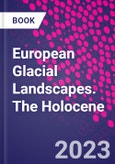European Glacial Landscapes: The Holocene presents the current state of knowledge on glacial landscapes of Europe and nearby areas over the Holocene to deduce the influence of atmospheric and oceanic currents and the insolation forcing variability and volcanic activity on Holocene paleoclimates, the existence of asynchronies in the timing of occurrence of glacier expansion and shrinkage during the Holocene, time lags between the identification of oceanic and atmospheric changes and those occurring in glacial extension during the Holocene, the role of Holocene glaciers on the climate of Europe, and on sea level variability, and the delimitation of landscapes that need special protection.
Students, academics and researchers in Geography, Geology, Environmental Sciences, Physics and Earth Science departments will find this book provides novel findings of all the major European Regions in a single publication, with updated information about Holocene glacial geomorphology and paleo-climatology and clear figures that model the landscapes covered.
Please Note: This is an On Demand product, delivery may take up to 11 working days after payment has been received.
Table of Contents
Part I
Introduction
1. Introduction to the Holocene glacial landscapes
2. Homogenisation of cosmic-ray exposure ages
3. Quaternary interglacials
4. Synthesis of Holocene glacial landscapes in Europe
Part II
Climate changes during the Holocene in eastern North Atlantic and Europe
5. Introduction to the Holocene climate
6. Greenlandian Stage (Early Holocene, 11.7_8.2 ka)
7. Northgrippian Stage (Middle Holocene, 8.2_4.2 ka)
8. Meghalayan Stage (Late Holocene, 4.2 ka_present)
9. Synthesis and perspectives: drivers, rhythms, and spatial patterns of Holocene climate change
Part III
The European glacial landforms during Holocene
10. Holocene glacial landscapes of the Russian Arctic and the Urals
11. Holocene glacial landscapes of Svalbard
12. Holocene glacial history and landforms of Iceland
13. Early Holocene glacial landscapes and final-stage deglaciation of the Fennoscandian Ice Sheet
14. Holocene glacial landscapes of the Scandinavian Peninsula
15. Holocene glacial and periglacial landscapes of Britain and Ireland
16. Glacial landscape evolution during the Holocene in Northern Central Europe
17. Glacial landscape evolution during the Holocene in the Tatra Mountains
18. Glacial landscape evolution during the Holocene in the Romanian Carpathians
19. Holocene glacier variations in the Northern Caucasus, Russia
20. Holocene glacier variations in the Alps
21. The Pyrenees: glacial landforms from the Holocene
22. Holocene glacial landscapes of the Iberian Mountains
23. Holocene glacial landscape of the Apennine Mountains
24. Holocene glacial landscapes of the Atlas Mountains, Morocco
25. Holocene glacial landscapes of the Balkans
26. Holocene glacial landscapes of the Anatolian Peninsula
Part IV
Synthesis of the European Landscapes during the Holocene
27. The European Glacial Landscapes from the Early Holocene
28. The European Glacial Landscapes from the Middle Holocene
29. The European glacial landscapes from the Late Holocene
30. Recent evolution and perspectives of European glacial landscapes








